Top 10 Things to Do in Lima: Is Lima Worth Visiting?


What are the top 10 things to do in Lima?
Map of Lima Peru: Where are the tourist attractions?
My top tips for visiting Lima:
1. Museo Larco: The best museum in Peru!
2. Miraflores: Lima’s upscale district by the ocean
3. The Museum and Archaeological Sanctuary of Pachacamac: Uncovering pre-Inca mysteries
4. Plaza de Armas: Lima's historic center
5. Parque de las Leyendas: a mix of animals, history, and greenery
6. Parque del Amor: Romance with ocean views
7. Indulge in the food in Lima
8. Basilica and Convent of San Francisco of Lima: History, architecture, and 25,000 secrets
9. Lima Desert: Huacachina isn’t the only sandboarding destination
10. Lima at Night: Sunsets, cocktails, and staying safe
The city of Lima is a big, unsightly slum in the middle of a desert. Not even Peruvians like it. Some downright despise it. Are there nice spots? Sure! Is the traffic crazy? Yes! Will you feel safe? Not really!
But it’s also full of surprises, so don’t skip it just yet. Lima has world-class museums, funky neighborhoods, incredible day trips, and is proudly South America’s food capital.
Geographically, Lima sprawls like it’s trying to escape itself. Nestled in a flat valley, it’s hemmed in by mountains to the east and the Pacific Ocean to the west, where the cliffs make a dramatic stop. With 10 million inhabitants, Lima is one of South America’s largest cities and the world’s third-largest desert city, after Karachi and Cairo. That means dust, chaos, and a whole lot of traffic.
And about that traffic… Driving in Lima is an idiotic idea. It’s action-movie level madness: frantic lane switching, U-turns in busy intersections, buses stopping in the middle of avenues because bus stops are apparently optional, and taxis honking at pedestrians like their lives depend on it (and maybe they do). The unspoken rule seems to be: drive as though no one else exists, then pray you make it out unscathed. Just take taxis.

There are plenty of interesting things to do in Lima
My tip: I’ve put together a 1-day Lima itinerary that takes you through all of the main highlights in this list and includes planning tips based on my own experience. I’ve also described how to get into and around Lima, all about the frustrating Lima airport, and answered plenty of FAQs that first-time travelers to Lima have.
Is Lima, Peru worth visiting?
Yes—but with a few caveats. Lima is worth visiting for its world-class attractions like the Larco Museum, the stunning ocean views from Miraflores, and, of course, as the gateway to the rest of Peru (thanks to its international airport).
Here’s the thing: Lima is chaotic, sprawling, and not exactly a city that will charm you on sight. But if you give it a chance, it reveals some incredible gems. The food scene alone, with its award-winning restaurants and unbeatable ceviche, is reason enough to stay an extra day.
So, should you skip it? No. Will you want to at times? Probably. But once you’ve explored its highlights, you’ll be glad you stuck around. Just come prepared for a little mayhem—it’s all part of the experience.


Lima is so worth it! But for the love of God, do not self-drive there...
What are the top 10 things to do in Lima?
- Museo Larco: Explore ancient Peruvian art and history in a beautiful mansion.
- Miraflores District: Lima’s upscale neighborhood with ocean views, a coastal sidewalk, and top-notch restaurants and hotels.
- Museum and Archaeological Sanctuary of Pachacamac: Discover a pre-Inca city with fascinating myths, pyramids, and a modern museum.
- Plaza de Armas: The birthplace of Lima, featuring iconic yellow buildings, wooden box balconies, and historic landmarks like the Cathedral of Lima.
- Parque de las Leyendas: A sprawling zoo combined with archaeological ruins and a small botanical garden.
- Parque del Amor: A small, romantic park in Miraflores with a colorful tiled wall and ocean views.
- Trying the best restaurants in Lima: Experience Peruvian food, from gourmet meals at world-famous restaurants to ceviche at local spots in Miraflores.
- Basilica and Convent of San Francisco: A stunning colonial church with eerie catacombs housing 25,000 skeletons.
- Adventures in the desert: Adventure awaits with sandboarding, dune buggy rides, and stunning views at Huacachina or Lomas de Ancón.
- Lima’s nightlife: Enjoy the city’s safer nightlife in Miraflores, with cocktail bars and scenic strolls.
Sometimes, all you need to do is take the first step... I've filtered out the best hotels in Lima for you
Save it for yourself to come back to later, or share with your friends on social media!
I've already planned your ititnerary for the trip, complete with my travel tips.
Map of Lima Peru: Where are the tourist attractions?
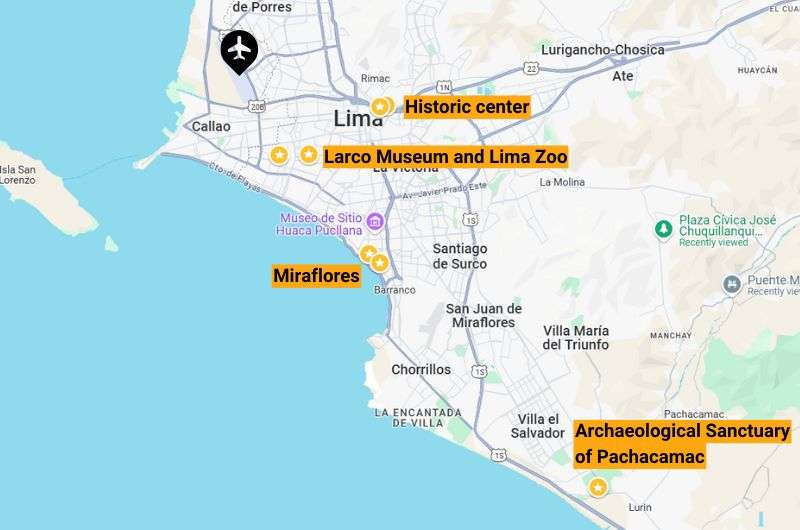
This map shows the locations of the top things to do in Lima, with the airport up towards the north and Miraflores being the best (and safest) place to find a hotel
My top tips for visiting Lima:
- Don’t rent a car in Lima—the traffic is nuts. Take the cheap taxis everywhere instead, and let the stunt-driving professionals handle the chaos.
- Eat ceviche as many times as you can. It’s Peru’s unofficial national dish, and Lima is hands down the best place to taste it!
- Skip the ocean for swimming—the water is chilly year-round unless you’re a Norwegian. Instead, take in the views from the Malecón.
- Time your visit to Museo Larco for the late morning or afternoon to avoid crowds and enjoy a relaxing lunch at their garden café.
- Use sunscreen, even if it’s cloudy. Lima’s UV levels are no joke, thanks to its desert location.
- Learn a little Spanish. Many locals don’t speak English, and a few phrases can go a long way in improving your experience.
- Base yourself in a hotel in the upscale and safe Miraflores neighborhood, which has great restaurants, shops, and stunning ocean views. I stayed at Radisson Red Miraflores and in Hilton Lima Miraflores and both were perfect.

1. Museo Larco: The best museum in Peru!

MuseoLarco.org
Jan’s tip: If you’re into Peruvian culture, this is the place to geek out over ancient art, bizarre sacrificial rituals, and a gold collection that’ll make your jaw drop. Don’t forget to save energy for the erotic pottery collection—yes, it’s a thing! Pro tip: Visit the museum café for a coffee and a snack while soaking in the views of the lush gardens.
I’ll say it: The Larco Museum is epic! It’s in a gorgeous mansion, it’s well organized, the descriptions are clear and informative, and you learn tons while oohing and aahing and understanding the history of ancient Peruvian civilizations.
This museum shows the large private collection of Rafael Larco Herrera who gathered, bought, stole, and otherwise acquired the amazing archeological pieces on display. Most of what you will see is art, ceramics, a gold and silver collection, textiles, and a famous erotic pottery collection.
You can buy your tickets in person or in advance on the official website (museolarco.org). Kids go for free, but make sure to still get them a ticket, as they will be included in the body count for your chosen time slot.

Examples of artifacts that can be seen in the Larco Museum
Each room in the Larco Museum is dedicated to one culture, so you get a nice overview of the evolution of Peruvian art (or lack of!) over the centuries. I mean it was fabulous when they made these things thousands of years ago, but when you see they were still making them in the 13th century, you can’t help but feel disappointed, not gonna lie. All that potential and still the same earrings?! Come on guys, step up your game!
Among the highlights of Museo Larco:
- You learn things like that the gods were happier if the sacrificed humans were wealthy or otherwise special. Top honor? If your child was chosen to be sacrificed.
- The Inca symbolism of the puma, the condor, and the snake that represented the world of the living, the world of the dead, and the upper world or heaven of sorts. And that plain old ducks trumped them all because they could dive, walk, and fly!
- The decorative head and face pieces made of various metals are incredible, not just because I can’t imagine those massive golden plates in my ears. You could serve dessert on them! Living back then must’ve really been something.

Imagine those massive silver plates in your ears! Ouch...
Museo Larco also has a café where you can get a quick bite and rest with views of the gardens from the terrace.
When you look at a map, it’s easy to forget how huge Lima is, and you might even toy with the idea of walking to the Larco Museum from your hotel in Miraflores. Don’t. It’s 10 km (6 miles), and you’re still in Lima’s sprawling cityscape, despite the glitz and glam of Miraflores. Be safe, take a taxi.
- Open daily 9 am–7 pm, Fridays and Saturdays until 10 pm
- Tickets cost PEN 40 (USD 10)
2. Miraflores: Lima’s upscale district by the ocean

Miraflores
Jan’s tip: Miraflores is where Lima’s coast shines brightest! Think safe streets, fancy restaurants, and endless views of the Pacific Ocean. Pro tip: Stay in this neighborhood—it’s safe, tourist-friendly, and has everything you need within walking distance, including great spots to watch the sunset.
Miraflores, like a little Miami in South America
I’ve mentioned the upscale Miraflores district many times in this article, and for good reason. It’s lovely and I didn’t feel like I’d get mugged! It sits to the south of central Lima atop the cliffs over the ocean, the rocks covered with nets that are overgrown by plants, turning mundane grey into a lovely and inviting green.
Miraflores looks a little like the nice parts of Miami and feels kind of like San Francisco, with tons of restaurants, shopping, top hotels, and great views. You can admire the sunset from the sidewalk that lines miles of Lima’s coast, and it really is spectacular, especially on clear nights with just a hint of high clouds.

Marvelous ocean views in Miraflores
Coastal sidewalk and Larcomar Mall
One place that gives you all the amenities, restaurants, coffee shops, shopping and views for days, is the Larcomar Mall that is built into the cliffs. It has an open plan, meaning the walkways are all outdoors, and you feel the ocean breeze at all times. You won’t notice Larcomar when walking in the street because it is literally right under you, the top being at street level. So, look down or you’ll miss it!
Parque Kennedy: the heart of Miraflores
Parque Kennedy, smack dab in the middle of Miraflores, is where the action is—all of it. This lively square offers endless options for eating, shopping, and soaking up the city vibes. You’ll find food stalls, restaurants, cozy coffee shops, and vendors selling handmade art and souvenirs.
The park is also famous for its resident cats. These furry locals roam around like they own the place (and honestly, they kind of do). Grab a churro or an empanada from a nearby stand, find a bench, and enjoy the perfect mix of people-watching and feline antics.
3. The Museum and Archaeological Sanctuary of Pachacamac: Uncovering pre-Inca mysteries

Pachacamac
Jan’s tip: If ancient ruins and fascinating myths are your thing, Pachacamac is a must-see. Visit in the morning during the summer months to avoid turning into a human popsicle under the blazing sun. Bonus points if you add this stop to your road trip down to Paracas—it’s on the way so you won’t need to backtrack.
Pachacamac archaeological site is an easy trip outside the city, located 40 km (25 miles) to the south of central Lima. It was a city of 20,000 people built in the pre-Inca times.
Pacha Kamaq (which means Earth Maker) was the creator god of the Peruvians before the Inca times. There are many myths surrounding this god, and I urge you to read up on him prior to visiting “his” city.
You’ll find out strange things, like why virgins were raised in this city for human sacrifice. Hundreds of female bodies were excavated from the Temple of the Sun.
Or that Pacha Kamaq created man and woman but forgot to give them food. After a whole fiasco in which the god was repeatedly beaten by the children of the surviving woman, he finally gave up and decided to become the god of fish.

Pachacamac is associated with a number of legends
Highlights of Pachacamac: temples, myths, and ruins
There is excavation going on to this day, uncovering hidden stories. You can walk around and see fascinating, well-renovated ruins, including temples, pyramids, storage facilities, a house for the soon-to-be-dead women, and even an Inca road.
The museum is delightfully modern since it was only inaugurated in 2016. The flat, white buildings of the museum are surrounded by white floor tiles and patches of bright green grass, which is a stark contrast to the orange/brown dirt and sand of the archeological site and excavated ruins. It displays the site’s most beautiful pieces.
Practical tips for visiting Pachacamac
- I recommend visiting Pachacamac early in the morning if you are visiting in the summer; it gets hot as heck fast.
- Tour the ruins first (1.5 hours) and then hide from the sun in the museum (1 hour). They also offer a tour if you want more info than you get from the information panels at the ruins. You can visit as a short day trip, or...
- Instead of going back to Lima, you can make Pachacamac an easy stop on your drive down to Paracas National Reserve, where stunning nature awaits.
- Pachacamac’s website offers worksheets for kids and adults, plus other materials in various languages that you can download and print out to make your visit more interesting. They’ve really gone the extra mile to make this historical site fun for everyone. There is also a café and shop on site.

These ruins are worth seeing
Details:
- Opening hours: Tuesday to Saturday 9 am–5 pm, Sundays 9 am–4 pm
- Tickets: PEN 15 (USD 4), guided tour PEN 50 (USD 13.50)

4. Plaza de Armas: Lima's historic center
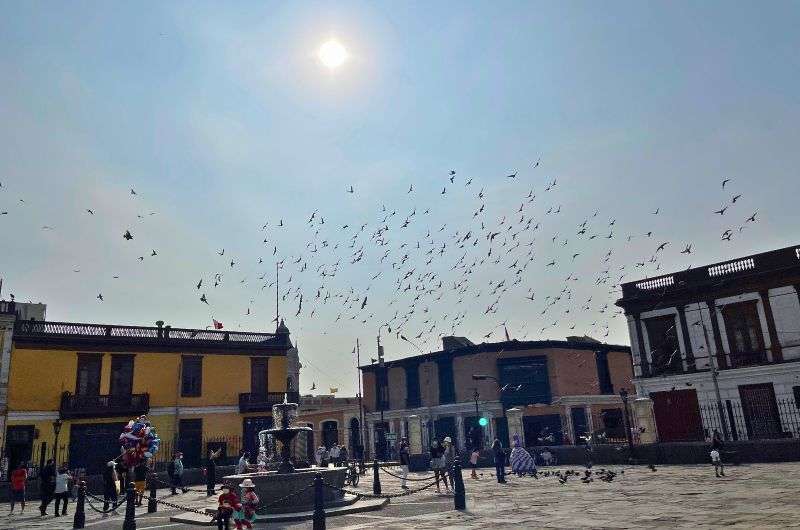
Plaza de Armas
Jan’s tip: This is where Lima’s historic center comes alive. Plaza de Armas is the very spot where Lima was born. Take your time exploring the architecture and snapping photos of those iconic yellow buildings. Look up at the famous box balconies—they’re both gorgeous and a little sneaky.
Plaza de Armas is the birthplace of Lima. Why? Because in 1535, Spanish conquistador Francisco Pizarro, following the set procedures of establishing cities in the New World, chose this location to build a plaza.
The procedure was simple: Decide where the main plaza of the new city will be, and that will be the city’s center. Split land surrounding the plaza into parcels and give it out to other conquistador buddies, making sure the streets form a grid.
The Plaza de Armas is the plaza that Pizarro designated as the center, and Lima’s historic center was born. It’s a sizeable central square with a fountain in the middle, palm trees, manicured grass, and curved flower beds going all around the edges.

Government Palace
Many typically yellow buildings surround the square, and they aren’t just cute; they’re the palaces where the important dudes sit:
- City Hall: The administrative center of Lima, housed in an elegant colonial-style building.
- Government Palace: Also called the "House of Pizarro," it’s the official residence and workplace of Peru’s president.
- Archbishop’s Palace: Known for its ornate facade and impressive wooden balconies, this is the seat of the Archbishop of Lima.
- Cathedral of Lima: A striking colonial cathedral, this massive church is home to Pizarro’s tomb and stunning religious art.
UNESCO heritage and Lima's iconic box balconies
UNESCO inscribed the historical center of Lima onto its Heritage List, and part of the reason why are the wooden box balconies you’ll see on most of the buildings on the plaza and in the surrounding streets.
But what are they for? For being nosy and knowing what everyone in the neighborhood is up to! Really, the women would be able to discreetly hang out on the balcony, which would be covered in cushions, and watch what’s happening in the streets. Pre-social media, an ingenious way to stalk your friends and foes.
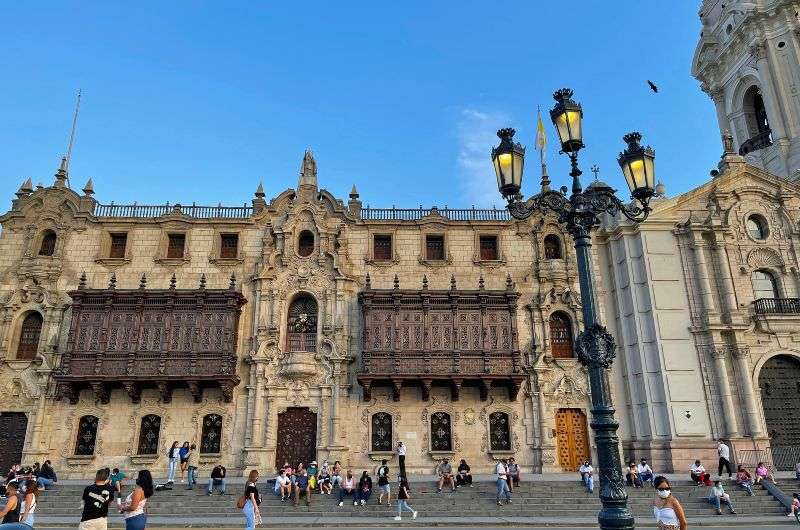
Lima’s iconic box wooden balconies aka the social media of yesteryear
Historically though, this is an Islamic concept, and since Muslim women weren’t meant to be seen by men outside their immediate family, the box balconies were a practical way for the ladies to go outside (well, sort of) without a care in the world. And spy on their neighbors.
The wooden carvings can be intricate, but some of the screens have now been replaced with glass on some buildings since nowadays people actually want to be able to see out of their living room properly. If you want to go be a cheeky lady and peek out of a screened box balcony, you can visit some of the historical buildings on the plaza, like the Archbishop’s Palace, and go out onto one.
I liked it.
Staying near Plaza de Armas
Tip: I prefer Miraflores for hotels, but if you want to stay closer to Lima’s historic center, book a hotel near Plaza de Armas.
5. Parque de las Leyendas: a mix of animals, history, and greenery

Parque de las Leyendas aka Park of Legends
Jan’s tip: If you’re looking to escape Lima’s grey streets, Parque de las Leyendas is your ticket to a day filled with animals, greenery, and a splash of history. It’s a place where archaeological ruins meet wildlife and a small botanical garden. Wear comfy shoes because this park is sprawling, and don’t forget to pack a bit of patience for the occasional crowd.
The Parque de las Leyendas, or "Park of Legends," is a large green space located in central Lima that offers a mix of attractions. It’s a zoo first and foremost, but it also includes a small botanical garden and pre-Hispanic ruins, making it a unique spot to explore.
A zoo with well-cared-for animals
The animals are mostly in spacious pens and appear well cared for, though, if you prefer to see animals in the wild, this ain’t that. The big cats are the stars of the show, and they have the best digs out of all the animals.
Ruins meet nature
The fact that the zoo was built on a pre-Hispanic site gives the park an interesting twist, with ruins of walls and terraces visible in some parts of the zoo. They are even part of some of the animals’ habitats. It’s like getting a history lesson while hanging out with llamas.
A small botanical retreat
The botanical garden isn’t massive, but it’s a pleasant diversion with a mix of trees, bushes, and a few flowers.
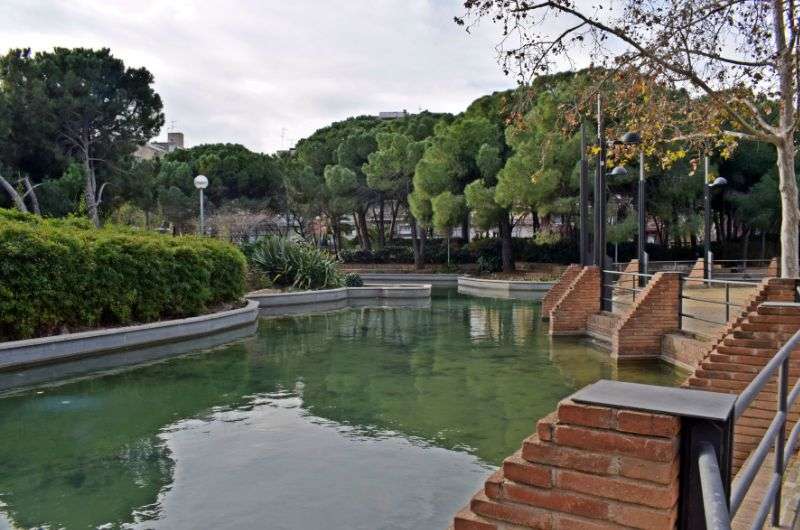
Parque de Las Leyendas is the place you can find a unique combination of flora and fauna in Lima
Practical tips for Parque de las Leyendas
- The park is huge, so plan for plenty of walking. Bring water, snacks, and sunscreen.
- There are a few food and drink spots inside the park, so you won’t go hungry.
- This is a great option for families or anyone looking to unwind and escape the hustle of the city for a few hours.
Details:
- Opening hours: Daily 9 am–5 pm
- Tickets: PEN 15 (USD 4)
6. Parque del Amor: Romance with ocean views
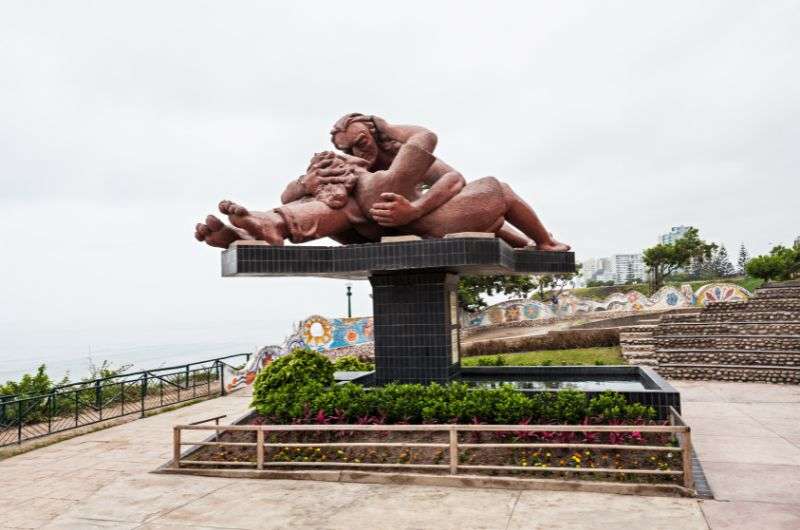
Amor time! In Parque del Amor
Jan’s tip: This park is perfect for a quick stop while exploring Miraflores. Time your visit for sunset to get those dreamy golden-hour photos. If romance isn’t your thing, just enjoy a crepe and laugh at the statue—it’s Shrek-level unforgettable.
This small “Park of Love” in the Miraflores district faces the Pacific Ocean and has wonderful views of the sunset. It’s romantic, or so they say, so head on over, love birds!
The centerpiece: an unforgettable statue
The centerpiece of the park is a statue with what looks like a pile of people, though there are just two—a man and a woman, their tangled bodies lying down, smooching. I can’t help but think the man looks like Shrek when he turned human for that half hour of his life.
A touch of Barcelona in Lima
Parque del Amor has a long, low wall with a wavy edge that is completely covered in tiny colorful tiles, just like you’d see in Park Guell in Barcelona.

Parque del Amor has Park Guell (Barcelona) vibes, doesn't it?
Snacks with a view
There is a crepes kiosk right in the park, so you can snack and sit while you gaze and kiss. Other than that, there’s nothing there, and you probably won’t write home about it.
7. Indulge in the food in Lima

Lima is the Peruvian culinary capital
Jan's tip: Lima's culinary scene is a melting pot of flavors that will make your taste buds dance the salsa. From Peruvian food classics to innovative fusion dishes, this vibrant city has it all. Start your gastronomic adventure in the Miraflores district, where there are lots of top eateries within walking distance.
Lima: South America's food capital (and top place to have pisco sours!)
Lima is supposed to be South America’s food capital, and I was very happy to put this title to the test. Anyone else here likes to eat like a king?
Let’s look at what the experts say: Peru won the World's Leading Culinary Destination at the World Travel Awards in 2023, and Latin America’s 50 Best Restaurants 2023 lists Maido in Lima as the top restaurant, with Kjolle and Mayta also securing spots in the top ten.
Tip: You have to try Peru’s famous drink: the pisco sour.
Dining at Astrid y Gastón: A legendary name in Lima’s culinary scene
Astrid y Gastón is no stranger to accolades. It ranked No. 30 on the 2022 Latin America's 50 Best Restaurants list and took fourth place in the Summum 2024 rankings of Peru's top eateries. With such a reputation, I was more than ready for a mind-blowing culinary experience.

Astrid y Gastón delicacies
I booked into Astrid y Gastón and really want to write about some of the best food of my life, but I can’t, because it wasn’t. I’m just too spoiled by all the delicious food I’ve eaten all over the world, and in my list, Astrid and Gastón place somewhere in the 200s. Sorry! I mean, it was good, but crème de la crème it was not.
Savoring ceviche in Lima
Peru’s national dish, ceviche, is not what I would typically opt for, but Lima did it well and not kidding, on some days, I ate it twice. Ceviche is a dish made from raw fish marinated in lime juice, most often served with sweet potato and corn. So healthy, so fresh, so good!
The Social Restaurant & Bar
The Social Restaurant & Bar, which is a street-level restaurant and part of the Miraflores Hilton Hotel, had a great ceviche tasting platter, plus other Peruvian-American fusion dishes on the menu. The service was great and spoke English, which is a welcome bonus.
Tip: If you are a foodie, you’ll want to read about what to eat and drink when visiting Peru. I’ve listed all the traditional foods, written about tasting llama meat, and ranted about the bad coffee and beer. Check it out.
8. Basilica and Convent of San Francisco of Lima: History, architecture, and 25,000 secrets

Basilica and Convent of San Francisco of Lima
Jan’s tip: Be strategic about the guided tour. The English ones fill up quickly, so arrive early to snag a spot, or risk enduring a dull Spanish tour like I did.
This isn’t just a church, it’s a whole religious precinct. UNESCO likes it, too, and it’s on the Heritage List along with some other parts of Lima’s historic center.
We took the guided tour, which took about an hour but felt like a decade. Not only was it in only in Spanish (which I do speak, so it wasn’t that big of a problem), but the guide lady was the most boring person on the planet. The tour seemed endless, so even though the interiors were nice, we were thinking about the outside world in about 30 minutes, missing the freedom and fun it provides.
Architectural highlights: the dome and Mudéjar style
When inside, you should definitely look up and admire the wooden design of the dome. It’s in a Mudéjar style, which brought back memories of our travels to Andalusia in Spain.

Basilica and Convent of San Francisco of Lima, details
The catacombs: macabre meets art
The tour of the convent ends in the catacombs with some 25,000 dead bodies as your host. These crypts were used as Lima's primary cemetery during the colonial period, and the bones are now arranged in intricate patterns, creating an eerie yet fascinating underground experience. All I could do was wonder about the untold stories and mysteries of the lives of these individuals.
Who’s ready for the tour to finally end? To be clear, the tour is also available in English, but since you go in on a first come, first served basis, you may need to wait a while. Or, take the boring Spanish-speaking lady.
- Opening hours: Daily 9 am–6 pm
- Tickets: PEN 20 (USD 5.50)
9. Lima Desert: Huacachina isn’t the only sandboarding destination
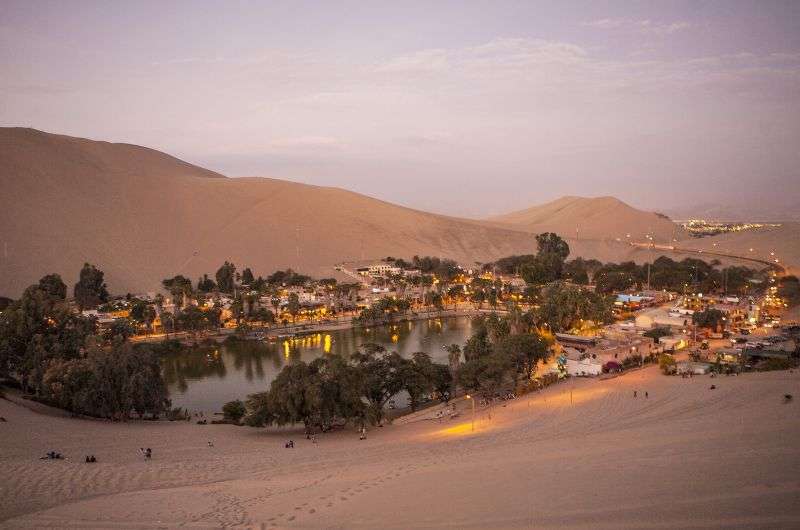
Huacachina
Jan’s tip: Don’t forget a scarf or bandana—you’ll thank me when you’re not chewing on sand for days.
I don’t like the desert, but it does offer some fun things to do close to Lima. You can go on desert tours, hikes, and try your hand at sandboarding. There are several options for desert activities near Lima.
Huacachina: Peru’s famous desert oasis
You may have heard of Huacachina, which is Peru’s desert oasis. It’s a town of about 100 permanent inhabitants, built around a small lake in the middle of the sand dunes. It attracts thousands of tourists every year, most of whom are there to surf the sand or go on dune buggy rides.
The sand dunes of Huacachina are incredible and a top spot to see in Peru, but they aren’t exactly close to Lima. Some people make the 4-hour drive out of Lima and back in one day, but I’m not one of those people. I recommend making Huacachina a stop on your trip to Paracas, which has plenty more fun activities to keep you occupied for a few days.


Finding oases in the vast desert is definitely a fun thing to do
Closer options: Lomas de Ancón
If you want to get sand stuck in all the wrong places, you can do that much closer to Lima, in Lomas de Ancón. The drive is about an hour north of the city. You’ll want to get on a tour and not try to drive there yourself. Not that you have your own sandboard in your suitcase.
Desert Expeditions have top reviews, so check them out (no affiliation, I just want to make a recommendation for a top company). You’ll get driven to the dunes in a 4x4 vehicle, through the rough parts of Lima that you wouldn’t dare to enter by yourself.
Once at the dunes, you can sandboard, sandski, or sandsled. They’ll usher you back up the hill in the car, so you don’t need to worry about hiking up a dune every time you tumble down to the bottom.
Off-roading with a bird’s eye view
If you’re more of an observer, you can take an off-roading tour for some epic bird’s eye views of the dunes. It’s less sandy and much more Instagrammable.
- Huacachina: 4-hour drive from Lima; ideally plan for an overnight stay in Paracas.
- Lomas de Ancón: 1-hour drive north of Lima; tours are highly recommended.
10. Lima at Night: Sunsets, cocktails, and staying safe

Time to experience some nightlife in Lima
Jan’s tip: Lima by night can be magical—if you know where to go. Stick to the safer neighborhoods like Miraflores and Barranco, and you’ll find great bars, incredible views, and even some low-key nightlife. Pro tip: Take a taxi to and from your destinations, and always trust your instincts.
In general, Lima’s nightlife scene is more sitting and drinking rather than dancing until dawn. And even though Lima is not the safest place, you can still enjoy the nightlife.
I’m not a party animal and if you ask me, I think the best thing to do in Lima at night is stay the F in your hotel. They have bars too, you know.
Miraflores and Barranco, two neighborhoods right next to each other along the shore in the southern part of central Lima, are the most popular and safest areas where you can get your nightlife on. One is my favorite option (Miraflores), and one has... well, street art. And then there’s San Isidro.
Where to go in Miraflores
Miraflores has a boardwalk, called Malecón, that takes you on top of the cliffs over the Pacific Ocean. The boardwalk is basically a sidewalk with views to one side and hotels and restaurants on the other. If you like a more relaxing evening, this is the place to be, as the sunset views are unbeatable.
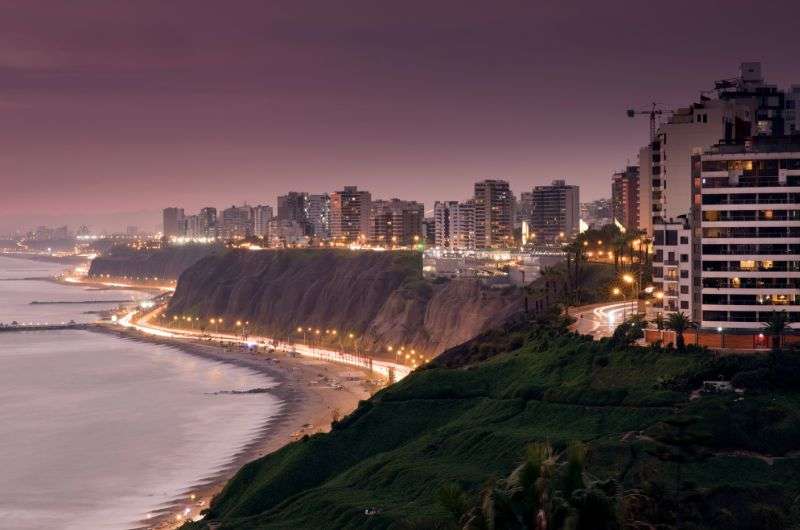
View from the Malecón
After sunset, head inland to one of the top bars in Miraflores called Open Tapas Bar (what a boring name, huh?). It’s a tad upscale, and you won’t be let in if you’re wearing board shorts and flip-flops, which is a plus in my book. The drinks and vibe are great.
Barranco... if you like street art
Overall, I think Barranco is just a slightly nicer slum and didn’t find it appealing at all, so you won’t find it high in this things to do in Lima list. Then again, I’m not into boho chic stuff and probably didn’t appreciate the street art as much as others do. You see rustic, I see grimy.
That said, Barranco does have a pretty good choice of bars, and I wouldn’t hate having a cocktail at Ayahuasca. It’s a restored villa from the 1800s and has multiple spaces and bars, both inside and in the courtyard. The décor is cool but classy, and they have great food, too. There are more bars that aren’t dumps in the near vicinity of Ayahuasca, so there’s that.
Where to go in San Isidro
If you’re looking for a more upscale, laid-back vibe, San Isidro offers a handful of classy bars and rooftop lounges perfect for a quieter night out. While it doesn’t have the bohemian energy of Barranco or the bustling scene of Miraflores, it’s worth a visit if you prefer your cocktails served with a side of elegance.

But remember to be careful when going out at night, not all alleys are created equal
Safety first: how to avoid getting into trouble at night in Lima
While you can enjoy Lima’s nightlife, remember that safety is key. Stick to the main streets, avoid walking in sketchy areas and dark alleys, and always have a plan for getting back to your hotel. Better yet, stay in your hotel! I always choose one with a nice bar.
When is the best time to visit Lima?
- Best time to visit: Summer (December to April) is the ideal time to visit Lima. The days are mostly sunny, with temperatures around 26°C (79°F), and the late afternoon clouds make for stunning sunsets.
- Winter (June to October): Winters are damp, foggy, and generally unpleasant, with temperatures around 18°C (64°F). Morning drizzle and persistent fog give the city a grey, slummy vibe that’s not the most inviting.
- Year-round humidity: Lima is humid all year, and you’ll practically taste the air—trust me, it’s not a compliment.
- Ocean temperature: The water is cold year-round, so unless you’re from Norway or Iceland, you might skip swimming and stick to enjoying the ocean views.

Summer in Lima is the best!
Is Lima safe for tourists? — Not really
I’m not one to pore over government travel advisories, freak out, and cancel trips. I tend to take things as they come, but I’ll be honest—Lima didn’t feel all that safe to me. The stark social inequality is hard to miss, and unfortunately, it fuels desperation that can lead to crime. While much of Lima’s crime targets locals, it doesn’t mean tourists are completely off the radar.
During the day, Lima is fine as long as you stay alert and keep your wits about you. Wandering off into slums or sketchy areas solo? Hard pass. And nighttime? Forget about taking a romantic midnight stroll through alleys unless your idea of romantic involves adrenaline-fueled danger.
As a general rule, the northern parts of Lima are sketchier, while the southern neighborhoods near the coastline are wealthier and feel more comfortable for tourists. For peace of mind, stick to neighborhoods like Miraflores, one of the safest and nicest areas in the city. It’s perfect for first-time visitors and offers all the conveniences you’ll need.

Miraflores is the safest neighborhood for tourists
Sometimes, all you need to do is take the first step... I've filtered out the best hotels in Lima for you
Save it for yourself to come back to later, or share with your friends on social media!
I've already planned your ititnerary for the trip, complete with my travel tips.
You might also be interested in reading:
- The Best 3-Day Cusco Itinerary with Sacred Valley Day Trip
- A 2-Week Peru Itinerary: A Day-By-Day Trip Plan
- How to Get to Machu Picchu
- The 10 Best Ruins to Visit in Peru
- Top 9 Places to See in Sacred Valley
This post contains affiliate links. I earn a small commission if you make bookings through my links, at no additional cost to you. Thank you for your support!
What are the top 10 things to do in Lima?
Map of Lima Peru: Where are the tourist attractions?
My top tips for visiting Lima:
1. Museo Larco: The best museum in Peru!
2. Miraflores: Lima’s upscale district by the ocean
3. The Museum and Archaeological Sanctuary of Pachacamac: Uncovering pre-Inca mysteries
4. Plaza de Armas: Lima's historic center
5. Parque de las Leyendas: a mix of animals, history, and greenery
6. Parque del Amor: Romance with ocean views
7. Indulge in the food in Lima
8. Basilica and Convent of San Francisco of Lima: History, architecture, and 25,000 secrets
9. Lima Desert: Huacachina isn’t the only sandboarding destination
10. Lima at Night: Sunsets, cocktails, and staying safe






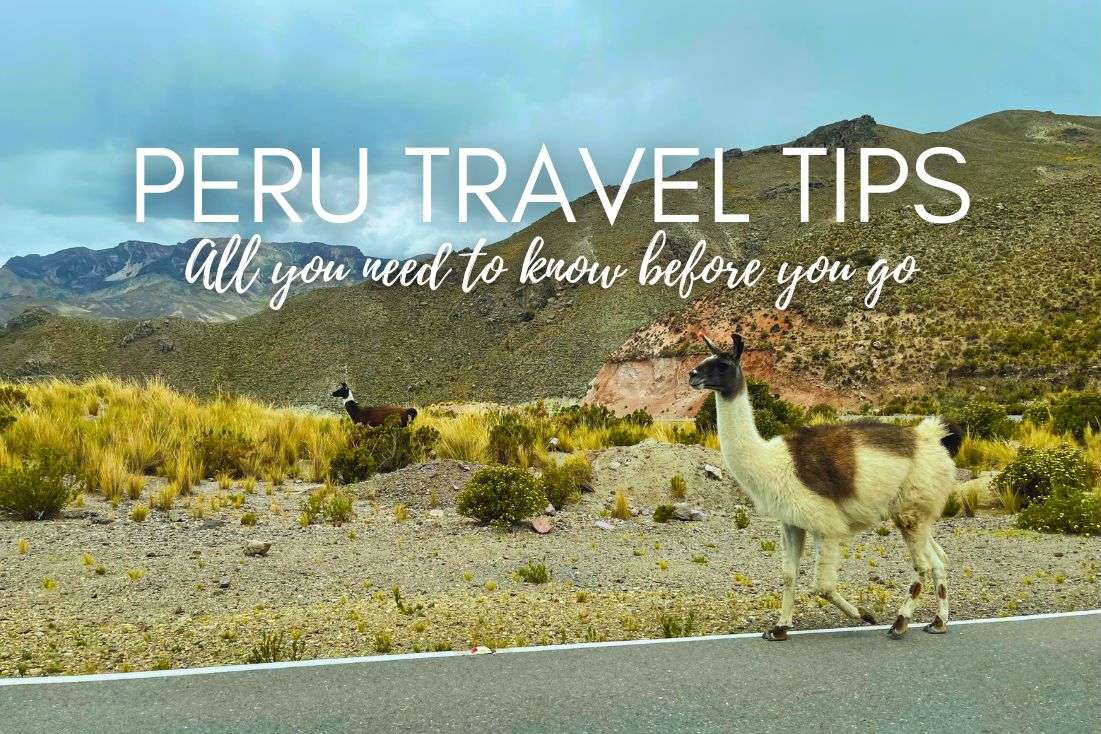



Comments | Thoughts? Give us a shout!